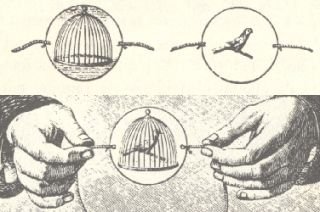From the Shadow Puppets of Java Island, about 5000 years BC, to our days' lenticular images, we discover a hole history of works and studies developed throughout the world, in which have participated artists, intellectuals and researchers as important and recognizable as Aristotle, Alhazen, Leonardo Da Vinci or Alberto Durero, with their studies on the obscure camera, as well as others, like David Brewster with his Kaleidoscope, Niépce and Daguerre with the invention of the daguerreotype and photography; William Dickson and Thomas Edison with honograph and kinetoscope, or the well known brothers Lumière with their cinematograph.
 However, what do we really consider as the main precursor of the lenticular image? To find it we should probably have to look to the traumatropo, a toy invented in 1824 by the British physician John Ayrton Paris, consisting of a disc with two different images on either side and a piece of rope that allowed to spin the disc quickly, producing an optical effect bonding between the two images.
However, what do we really consider as the main precursor of the lenticular image? To find it we should probably have to look to the traumatropo, a toy invented in 1824 by the British physician John Ayrton Paris, consisting of a disc with two different images on either side and a piece of rope that allowed to spin the disc quickly, producing an optical effect bonding between the two images.
The development of this invention was intended to demonstrate the principle of persistence of vision among his medical colleagues, but it eventually became a popular fixture in the Victorian England.
This simple but innovative invention laid the foundation for more complex ones, as the zoetrope or strobe machine (1834), consisting of a circular drum with open grids through which the viewer could see some drawings arranged in strips which by turning became into the illusion of movement.
Very similar was the praxinoscope of Émile Reynaud, 1877, with the innovation of having angled mirrors to reflect images drawn around and allowing a greater clarity to the optical outcome.
 After these simple but even complex inventions we would see the world to be impressed with the kinetoscope, the phonograph and the cinematograph, whose paths moved to our current cinema, but the basic principle - the passing of frames or still images at high speed to achieve the effect motion – return us to the principles forged in 1998 with Rufus Butler Seder in his kineticard and scanimations. This filmmaker, or more specifically, Optical Animated Artist, succeeds in creating the first holographic illusions by large panels engraved with fluted tiles torch on lenses, about eight inches each, which added together managed to create the effect of a change as the observer walked in front of them.
After these simple but even complex inventions we would see the world to be impressed with the kinetoscope, the phonograph and the cinematograph, whose paths moved to our current cinema, but the basic principle - the passing of frames or still images at high speed to achieve the effect motion – return us to the principles forged in 1998 with Rufus Butler Seder in his kineticard and scanimations. This filmmaker, or more specifically, Optical Animated Artist, succeeds in creating the first holographic illusions by large panels engraved with fluted tiles torch on lenses, about eight inches each, which added together managed to create the effect of a change as the observer walked in front of them.
It would be almost ten years until the arrival of the famous Colin Ord and his Magic Moving Images, or what is now known as kinegrams.
The kinegram consists of two elements: one with drawings, frames or graphics pattern called to acquire motion. The second is a transparent plastic screen with striped stripes which act as lenses. By overlaying said lens base on drawings, as the desired effect is achieved either tridimentional image or a motion effect on it.
 The lenticular effect is very similar but different. In this case the base is a special picture or drawing prepared with the different phases of the movement that seeks to achieve. Over it is placed a plastic sheet with a striped pattern that will make to appear or disappear parts of the base image as the lenticular object move.
The lenticular effect is very similar but different. In this case the base is a special picture or drawing prepared with the different phases of the movement that seeks to achieve. Over it is placed a plastic sheet with a striped pattern that will make to appear or disappear parts of the base image as the lenticular object move.
But both the lenticular and the kinegram have existed before Seder and Ord, or at least its idea. In 1910 a similar system to Seder Postal was patented and we can even find references to the existence of pre-kinegrams in late nineteenth century paintings.
Therefore, the fact is that the desire of human artistic spirit has taken us through the history to find the recreation movement. A craving that today we identify as natural and common when we watch it at our TV screens or at the cinema, but nevertheless it is much more amazing and spectacular when we find it printed on cards and objects that can be moved and taken in hand.
The ability to print and develop such devices has opened the doors of its technology to many applications.
Hence the lenticular industry has a significant importance on marketing strategies by physical media, providing an added value to the creative ideas emerging from the design and advertising studios.
Jun





